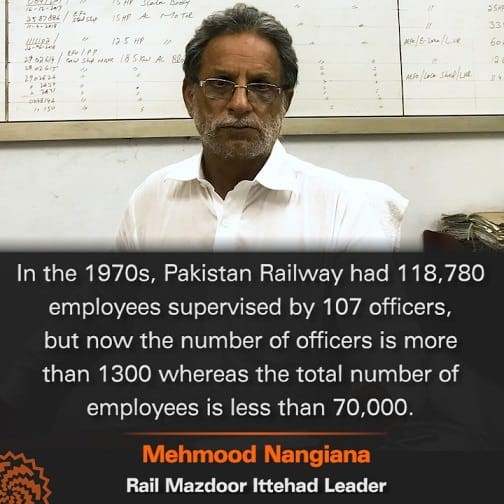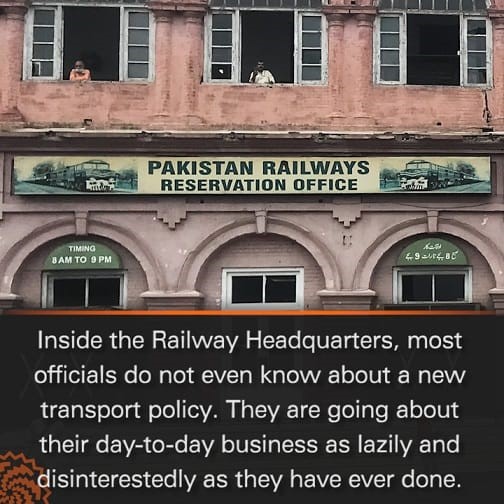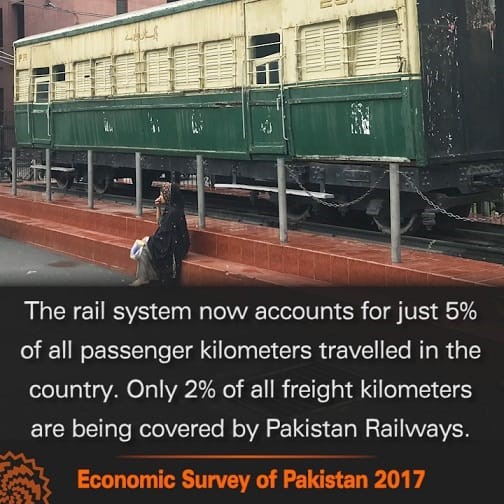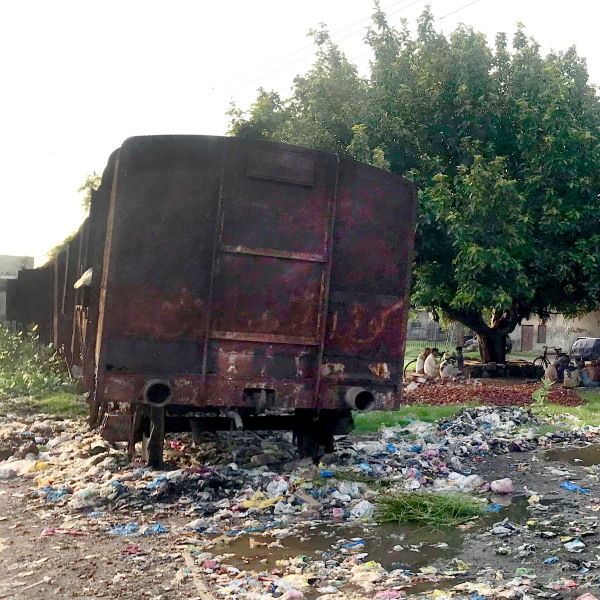The head of Pakistan Railways’ safety section is reportedly infected by coronavirus and is isolating at home. His air-conditioned office, meanwhile, has become a refuge for his subordinates harried by Lahore’s oppressive July heat. In the presence of their boss, this would be a forbidden luxury for them.
In the long corridors of Railway Headquarters, a drab redbrick building on Lahore’s Empress Road, staff members idling away their time like this is a common occurrence. Within this warren of a building, a carpeted staircase leads to a corridor that houses the offices of Pakistan Railways’ top management. These offices, opulent and grand as they are, are empty – without exception. Their occupants are either on vacations, doing official tours, gone on medical leaves or, in the words of their subordinates, have “just gone out to run some errands”.
Each absent officer’s personal staff is cramped in a smaller anteroom. Every outsider has to be scrutinized by this staff before he or she is allowed to move ahead. Entry to the officer’s room, indeed, requires a lot of convincing and cajoling – and could yet be denied.
This colonial-era distinction between ordinary citizens, low-level functionaries and officers is being maintained to preserve a fast fading and false sense of grandeur. It costs Pakistan Railways an arm and a leg: tens of billions of rupees of government money are being lost inside Railway Headquarters every year -- more of this will come a little later.
Yet any queries about this state of affairs meet an impenetrable wall of silence. “If you want to talk about the railway’s institutional and financial problems, you should see someone at the workers union office,” suggests a personal staff member for a top rail manager. “They know everything better than these officers who, in any case, will not tell you anything.”
Mehmood Nangiana, one of the most informed union members, however, does not work at Railway Headquarters. Due for retirement in eight months, he supervises a shop floor within Pakistan Railways sprawling workshops in Lahore’s Mughalpura area.
On a recent July day, he talks about the railway’s rise and fall with a gripping rhetoric peppered with facts that flow from his mouth as if he has memorized them. He remembers the 1970s as a somewhat golden era when, according to him, Pakistan Railways was making profit.
But without being nostalgic about that long gone era, he suggests that the rail’s downfall in Pakistan has overlapped with an increasing imbalance between its employees and its officers.

“In the 1970s, Pakistan Railway had 118,780 employees supervised by 107 officers,” he says, “but now the number of officers is more than 1300 whereas the total number of employees is less than 70,000.” Most of these officers, according to Nangiana, also do not possess the technical know-how required for running the rail system.
His words reveal an open secret: Pakistan Railways is a failed institution where corruption is rampant and bureaucratic and business practices are at least 50 years behind the rest of the world. Consequently, it has not made profit for more than a quarter of a century now.
The government’s own documents confirm this. In a report submitted to the National Assembly on 21st May 2021, minister for parliamentary affairs revealed that Pakistan Railways has suffered a loss of around 119 billion in the last three years. Reports prepared by the Auditor General of Pakistan show the railway management has failed to provide evidence for 100 billion rupees worth of expenditure in the last two years.
As a result of this corruption and financial mismanagement, Pakistan Railways has been running on an annual federal government subsidy of 37 billion rupees as well as a State Bank of Pakistan overdraft of around 40 billion. (An overdraft is money withdrawn in excess of the amount in a bank account). The need for this subsidy has remained a permanent part of the railway’s finances in recent times even though its earning went up by 9.96 percent in 2018-19.
Its descent into disorder has also been complemented by its growing irrelevance.
Till the end of the 1960s, Pakistan Railways was the primary mode of transportation of passengers and freight across the country.
According to the government records, its share in inland traffic in that decade was 41 percent for passengers and 73 percent for freight. As of now, these numbers have been reduced to 10 percent and four percent respectively.
According to the Economic Survey of Pakistan’s 2017 edition, the rail system now accounts for just five percent of all passenger kilometers travelled in the country. The numbers for freight travel are even more meager: Only two percent of all freight kilometers are being covered by Pakistan Railways.
No one is responsible because everyone is responsible
The government’s response to the railway’s complex crises has been equally complex (and yet very simple): everybody is doing whatever they can but no one really knows what they ought to be doing. A vivid lack of direction is the hallmark of Pakistan Railways – thanks mainly to its administrative structure that is incompatible with modern governance systems and business operation requirements.

As things stand today, it is a part of the federal ministry of railways which is based in Islamabad and is led by a federal minister who is assisted by a federal secretary and a cabal of additional secretaries, deputy secretaries, section officers and hundreds of other staff members. Yet, Pakistan Railways has its own chairman and a host of general managers who are based at Railway Headquarters in Lahore.
Experts like Richard Bullock – who has more than 35 years of experience in analyzing transport systems -- believe this model needs to be scrapped immediately. He addressed a webinar recently and explained that many countries have done away with such archaic bureaucratic models and replaced them with more dynamic institutional arrangements. He then advocated the merging of Pakistan’s federal railways ministry into a ministry of transport and suggested a separation of the government’s “governance role from the business management of railway transport services”.
The government’s efforts in this direction, however, remain lackluster at best and non-existing at worst.
Pakistan Railways’ top-heavy administrative system, meanwhile, does not face any pressure to improve its performance: No one fears losing their job for doing nothing. The railway officials do not get promoted or demoted on the basis of their performance – or the lack thereof.
In a direct consequence of this situation, Pakistan Railways lacks any system of internal accountability. The government’s own documents reveal scores of cases of fraud, embezzlement and irregularities in the railway during the last two years alone. In his 2019-2020 audit report for Pakistan Railways, the Auditor General of Pakistan highlighted corruption under at least 126 heads. The total amount embezzled in all these instances amounted to a massive 51 million rupees. The 2018-2019 audit report similarly highlighted hundreds of irregularities worth 97 billion rupees – making the Auditor General to suggest that the internal financial controls in Pakistan Railways need to be “revamped and redefined.”
These audit reports also flag anther issue: that hundreds of acres of land belonging to the railway have been encroached upon in Lahore, Karachi and other urban areas. Existing and former railways employees, slum dwellers and some real estate developers have constructed houses and other buildings on that land but the railway neither has the will nor the might to get any of it back.

The most high profile case concerning land has been the one around Lahore’s Royal Palm Golf Club built on a 103-acre golf course originally reserved for the railway officers. In 2000s, three former military officers – then federal railways minister Lieutenant General (retired) Javed Ashraf Qazi, then chairman Pakistan Railways Lieutenant General (retired) Saeed ul Zafar and then general manager railways Major General (retired) Hamid Hasan Butt -- gave it on a lease to a private company. When the final details of the lease became public, the company had been given an additional 41 acres of land and the tenure of its lease had also been increased from the original 33 years to 49 years – all without any additional payment of money.
These changes, according to various government reports, have caused a loss of 9.6 billion rupees to the national exchequer but Pakistan Railways public relations office does not say if any action has been taken against those responsible for it. Its director, Nazia Jabeen, only insists that the railway has a “zero tolerance policy on corruption”.
Her office uses similarly evasive language about other issues. Its functionaries, for instance, say that information about the performance of specific sections can only be obtained from those sections. Even when asked about accidents, an information office functionary says: “All the data has been given to the media so the media should be asked for it” – as if the information has been deleted from official records after it has been handed over to journalists.
Workers of the world, go home
Some former employees of Pakistan Railways protested at Kotri railway station in Sindh against the non-payment of their pensions in April 2021. They wanted Azam Swati, the railway minister, who was there on an official visit, to take note of their problem. He, instead, told them: “You have no right to claim your pensions because you have caused a loss of 1.2 trillion rupees to my country.”

His comments enraged every existing and former rail employee but the fact of the matter is that Pakistan Railways does suffer from overstaffing. A recent report by the Pakistan Institute of Development Economics (PIDE), a government think-tank based in Islamabad, reveals that its workforce has come down from close to 120,000 employees in the 1970s to less than 70,000 employees now. But even this reduced workforce is more than what it should be in accordance with regional standards.
The numbers are telling in this regard: Pakistan Railways had 72,078 employees in 2018 when it carried 60 million passengers; in other words, one staffer was deployed to carry 832 passengers; in contrast, one railway staffer was deployed to carry as many as 7.5 times more passengers in India in 2020.
Besides the downsizing of its employees, the other tool often used by Pakistan Railways to get out of its morass has been the privatization of various chunks of its business. This process was initiated in 1998 when the World Bank gave Pakistan 460 million dollars for restructuring the railway into three core parts: freight, passengers and infrastructure. A resettlement agency was also to be set up to “retain all surplus assets and liabilities, including labor, real estate, debt and environmental cleanup obligations”.
The plan did not work.
Though private sector was allowed to run several trains but this only added to the railway’s losses through unpaid dues, with private operators soon relinquishing their contracts without completing them. Two private trains operated in 2000s and 2010s have also been far from being unqualified successes.
Recently, the government has revived privatization plans by handing over certain rail functions to private investors. In October 2020 alone, the running of eight trains was handed over to private sector. More such moves are also in the offing. As Jabeen puts it, this will help Pakistan Railways further decrease the size of its workforce.
Nangiana and other union leaders, on the other hand, believe the government is missing the forest for the trees. In their opinion, downsizing and privatization processes will deprive Pakistan Railways of its experienced human resources without improving its performance. “The government thinks it can cut costs by closing down certain railway sections but why doesn’t it think of finding some new modes of earning money?” he asks.
Also Read

On a wing and a prayer: How train drivers tempt fate each time they embark on a journey
A bigger problem than overstaffing, according to Nangiana, is that a sufficient amount of money is often not available on a timely basis for projects and activities that can keep the workforce engaged. To make his point, he says the shop floor he supervises has 300 workers and requires materials worth around 50 million rupees each year to utilize its maximum capacity. “This floor received only 1.2 million rupees last year,” he says. “If the government does not provide enough material to keep all the workers busy, what will they work on?”
Scrambling for solutions
Most of the government’s hopes to improve the lot of Pakistan Railways are pinned on ML-1 – a new two-lane rail track to connect Peshawar with Karachi. This 1,872 kilometer long track is a part of the China-Pakistan Economic Corridor (CPEC) being financed by China. It will substantially increase the speed of passenger and freight trains and will have computer-based signaling and traffic control systems.
The investment in this line is also expected to address a major imbalance in Pakistan’s transport policies which have preferred roads over rails for the last three decades. This is despite the fact that rail travel, according to Amer Zafar Durrani, who heads Reenergia, a private social development consultancy firm, is around six times cheaper than road travel and is also cleaner and safer.
Yet, the preference for roads persists in Pakistan’s transport policies. This is exactly what Pakistan Railways’ 2019-2020 audit says about the latest National Transport Policy formulated in 2018: “It has been found that Pakistan Railways has not been prioritized by the government [in the policy] owing to which less allocation of resources [for it] has been made under the PSDP [Public Sector Development Program) as compared to road sector”.
Inside the Railway Headquarters, most officials do not even know about a new transport policy. They are going about their day-to-day business as lazily and disinterestedly as they have ever done – all the while thinking of ways and means to make some quick bucks.
This is best illustrated by a phone call a workshop supervisor receives on a recent July day. After he picks up his cell phone, he hears his boss asking him to jack up sales tax on a purchase invoice from 17 per cent to 40 per cent. He refuses to oblige and responds: “You will get all the money and I will get caught because the invoice will have my signature”.
The supervisor, then, reveals that his refusal will not make much of a difference – except that his own hands will remain clean. “The boss will now call someone who is not strong enough to refuse his command and will get what he wants,” he says.
This report was first published by Lok Sujag on 28 Jul 2021, on its old website.
Published on 10 Jun 2022




















